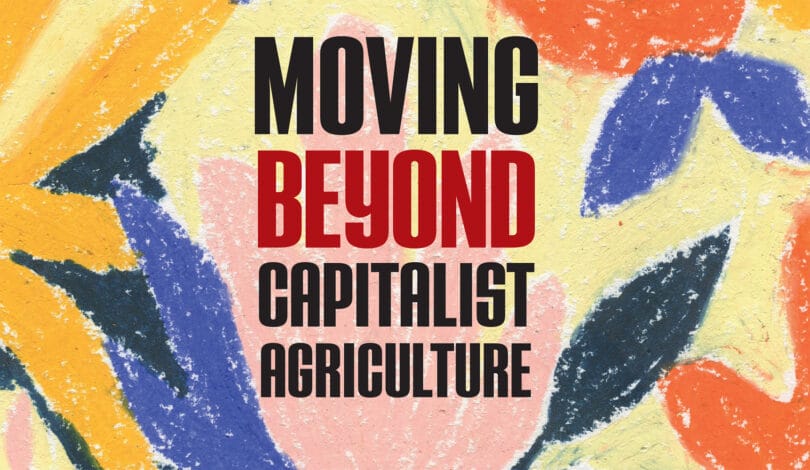 Cover of Moving Beyond Capitalist Agriculture: Could agroecology prevent further pandemics? by Pandemic Research for the People.
Cover of Moving Beyond Capitalist Agriculture: Could agroecology prevent further pandemics? by Pandemic Research for the People.Moving Beyond Capitalist Agriculture: Could Agroecology Prevent Further Pandemics?
Posted Aug 01, 2021 by Pandemic Research for the People
Agriculture, Capitalism, Climate Change, Culture, Ecology, Empire, Environment, Health, Imperialism, Inequality, Media, Movements, Political EconomyAfrica, Americas, Asia, Europe, GlobalDaraja PressDaraja Press, Featured
Moving Beyond Capitalist Agriculture: Could Agroecology Prevent Further Pandemics? is part of a collaboration between Daraja Press and Monthly Review Essays. You can obtain the work here as a printed pamphlet from Daraja Press. Please consider buying a copy, reviewing the other excellent publications from Daraja Press, and donating here. If you would like to receive more copies of the pamphlet for use in organizing, you can request a discount here.
This pamphlet is part of the joint series, Thinking Freedom and Moving Beyond Capitalism – Now! If you would like more information about the series, including how to participate as an author, please go here and here.
Firoze Manji, publisher at Daraja Press, and Howard Waitzkin, editor of “Moving Beyond Capitalism – Now!,” coordinate this collaboration.
***
Pathogens repeatedly are emerging from a global agrifood system rooted in inequality, labor exploitation, and unfettered extractivism by which communities are robbed of their natural and social resources. A crisis-prone economic system that prioritizes production for profit over meeting human needs and ecological preservation is organized around intense monocultural production that, along the way, allows the deadliest of diseases to emerge.
Pandemic Research for the People (PReP) focuses on how agriculture might be reimagined as the kind of community-wide intervention that could stop coronaviruses and other pathogens from emerging in the first place. We address how mainstream science supports the same political and economic systems that helped produce the pandemic. Then we introduce agroecology, an environmentalism of the peasantry, the poor, and indigenous, long in practice, that treats agriculture as a part of the ecology out of which humanity grows its food. Agroecology—a science, movement, and practice—combines ecological science, indigenous and peasant knowledges, and social movements for food and territorial sovereignty to achieve environmentally just food systems.
Peasant- and indigenous-led agroecology is uniquely positioned to limit the spread of zoonotic viruses: Post-capitalist agroecology champions the indigenous and smallholders who protect agricultural biodiversity. A diverse agroecological matrix of farm plots, agroforestry, and grazing lands all embedded within a forest can conserve animal biodiversity in the landscape. Agricultural biodiversity can make it more difficult for zoonotic diseases to prevail. Such a mode of conservation also takes into account the economic and social conditions of people currently tending the land, rather than a conservation that uproots people to foster the private accumulation of capital.
Moving Beyond Capitalist Agriculture is born out of the coordination between scholars and community organizers and it should be shared widely. The group behind it, the Pandemic Research for the People, is an expression of collective wisdom and necessary unease. In fact, organization and solidarity are two values to be cherished in this moment of multiple crises. COVID-19 is a neoliberal disease and agroecology that frees the land and people of greed and towards food sovereignty is the pathway out of this mess.
– Saulo Araujo, US Friends of the Landless Workers Movement
If you want to know more about the connections between racial capitalism, industrial agriculture, environmental destruction, and epidemics and pandemics, then this is a great place to start. But this pamphlet is more than just an analysis of the immense problems generated by capitalism. More importantly, this pamphlet represents an attempt to overcome this system and to develop revolutionary alternatives to it. Rather than falling into the tempting illusion of reform, the authors of these texts give invaluable insights into how we might support and develop revolutionary forms of agro-ecology that can sustain and reproduce life outside of the racial capitalist machine that is destroying it.
– Arturo Castillon, co-author, The Revolutionary Meaning of the George Floyd Uprising
Increasingly threatening climate disaster coinciding with a pandemic has tragically illustrated that the world doesn’t have the luxury of dealing with one crisis at a time – and capitalist agriculture is at the root of both.
The authors show convincingly that there is a better way: one that’s based on self-determination and building on human cooperation, not competition. This publication makes a strong case for agroecology as a crucial part of a future that puts people above profit; a future that assures people`s health by allowing planetary health to flourish.
It will bring clarity to everyone trying to understand how the next pandemic could be averted whilst building a more just world
– Vijoleta Gordeljević, Health economist and environmental health policy expert, People’s Health Movement.
Table of Contents
Introductory note, Howard Waitzkin
Globalized food systems, structural inequality, and COVID-19, Rob Wallace, from PReP Outbreak Origins
What is mutual aid? A COVID-19 primer, John Gulick, Jasmine Araujo, Cora Roelofs, Tanya Kerssen, Meleiza Figueroa, Etant Dupain, Serena Stein, Deborah Wallace, Ryan Petteway, John Choe, Luca de Crescenzo, Audrey Snyder, Colin Kloecker, and Rob Wallace, from PReP Neighborhoods
Can agroecology stop COVID-21, -22, and -23? Moving Beyond Capitalist Agriculture, Alexander Liebman, Tammi Jonas, Ivette Perfecto, Lisa Kelley, Henry Anton Peller, Salvatore Engel-Dimauro, Kevon Rhiney, Philip Seufert, Luis Fernando Chaves, Luke Bergmann, Kim Williams-Guillén, Max Ajl, Etant Dupain, John Gulick, and Rob Wallace, from PReP Agroecologies
Introductory note

Cover of Moving Beyond Capitalist Agriculture: Could agroecology prevent further pandemics? by Pandemic Research for the People.
Howard Waitzkin
Pandemic Research for the People (PReP) is doing some of the world’s most important work in understanding and responding to the COVID-19 pandemic, as well as helping to prevent similar and even worse pandemics in the future.
With participants spanning multiple countries, PReP has become a interdisciplinary network of farmers, scientists in biology and the social sciences, and revolutionary activists. People in PReP collaborate with a common motivation to move beyond capitalist, industrial, racist agriculture. This destructive approach to agriculture, which arose fairly recently in human history, they identify as the main cause of dangerous, “zoonotic” infections that move from animals to human populations. Such unsafe conditions arise mainly due to destruction of forest habitats that previously buffered emerging infectious diseases so they did not spread, and due to the industrial production of meat, which fosters the emergence of ever more dangerous pathogens that cause life-threatening infections in humans and other animal species.
To move beyond the agriculture of racial capitalism, PReP is fostering an “agroecological” transformation to safer, less exploitative, more sustainable, and more enjoyable ways to produce food. These creative practices allow ecologically based food production not based on exploitation, racism, and capital accumulation. Agroecology also fosters the restoration of natural habitats that help prevent emerging pandemics.
During the COVID-19 pandemic, PReP has produced a sequence of “dispatches” that focus on the pandemic’s causes, communities’ creative responses, and agricultural innovations that help prevent future pandemics by moving beyond agricultural practices rooted in racial capitalism. This manifesto/pamphlet, which is part of the series on “Moving Beyond Capitalism – Now!”, contains three of PReP’s dispatches, which focus on causes, responses, and preventive efforts linked to revolutionary transformation. Another important manifesto/pamphlet in the Moving Beyond Capitalism – Now! series also addresses important complementary themes: Abolitionist Agroecology, Food Sovereignty and Pandemic Prevention, by Maywa Montenegro de Wit.
The first dispatch presented here is “Globalized food systems, structural inequality, and COVID-19,” written by Rob Wallace and submitted from the PReP Outbreak Origins subgroup. As an evolutionary epidemiologist, Rob has studied for over two decades how agricultural corporations “farm pathogens” leading to epidemics through destruction of natural habitat and through industrial production of meat. In the creation of capitalist, globalized food systems, patterns of structural inequality based on social class hierarchies and racism become ever more apparent and problematic. This dispatch gives an helpful overview of these conditions, from the perspective of early during the COVID-19 pandemic.
In “What is mutual aid? A COVID-19 primer,” members of the PReP Neighborhoods subgroup analyze the transformative process of mutual aid. Communities around the world have carried out pathbreaking mutual aid projects in response to the overwhelming needs for food, housing, and services that arose during the pandemic due to a lack of adequate safety nets in capitalist countries. They trace the origins of mutual aid in anarchist thought and practice, including that of the biologist and “revolutionist” Peter Kropotkin. In his influential study of cooperation among animals, Kropotkin showed that mutual aid, rather than only competition among species, emerged as an important benefit in biological evolution. Carefully distinguishing between mutual aid and charity, the PReP dispatch emphasizes that mutual aid aims toward societal transformation beyond the injustices of racial capitalism. They describe the important components of revolutionary mutual aid practices that have emerged during the pandemic throughout the world, with detailed examples from groups like Southern Solidarity in New Orleans.
“Can agroecology stop COVID-21, -22, and -23? Moving Beyond Capitalist Agriculture,” produced by members of the PReP Agroecologies subgroup, provides concrete steps to achieve a post-capitalist, non-exploitative, anti-racist, sustainable, and joyful process of food production. This approach also has the tremendous advantage of restoring natural habitat and reducing industrial production of meat, which are key goals in changing the dangerous conditions of capitalist agriculture that cause pandemics. An important theme is that peasant- and indigenous-led agroecology limits the spread of zoonotic viruses by protecting agricultural biodiversity and enhancing food sovereignty.
The inspiring, multifaceted work of PReP scientists and activists points our way to a revolutionary transformation of agriculture and public health. Their path-breaking observations about the relationships among capitalist industrial agriculture, habitat destruction, and emerging epidemics and pandemics have focused attention on the upstream causes of pandemics, rooted in the structures of racial capitalism that have shaped the global production and distribution of food. Such structural conditions cannot be modified by technological solutions such as vaccines or medications or by piecemeal reforms. Through their scientific work and their political praxis, those who participate in PReP are providing crucial leadership and hope in transforming some of the most important components of the enormous crisis that confronts our planet and its inhabitants. We are grateful for the opportunity of facilitating these crucial efforts through this publication, and we invite your participation.
Globalized food systems, structural inequality, and COVID-19
Rob Wallace
PReP Outbreak Origins
The following is the revised text of a talk PReP’s Rob Wallace originally gave on April 16, 2020, at a Transnational Institute webinar in conversation with organizers Moayyad Bsharat, Arie Kurniawaty, Sai Sam, and Paula Gioia from, respectively, Palestine, Indonesia, Myanmar, and Germany by way of Brazil. The presenters talked through how SARS-CoV-2, the COVID virus, evolved out of the very structural inequalities it is also now exacerbating. The webinar is available in full here.
Thank you very much. It’s a pleasure to be here in spite of our present circumstances.
Inequalities in outcomes based on different policies and practices
Let’s begin with the status of the pandemic. The Johns Hopkins global map has us this morning at 5.5 million confirmed COVID cases worldwide and 350,000 dead.1 Given the counts some countries are reporting as suspected cases, this confirmed caseload is likely 5 to 10 times an underestimate.2 So at worst as many as 50 million people have to this point been infected – some more critically than others. For the worse outcomes – with uneven testing across the globe and some areas stretched to medical capacity – deaths are also likely undercounted.3
More than a quarter of the confirmed cases have been situated in the United States, with large outbreaks in Europe and the Middle East. The global South already began its own run up the epicurve, in a context of comparatively lesser public health capacity, fewer household resources for sheltering-in-place, and a wider array of underlying co-morbidities – that is, other health conditions that can complicate a COVID infection.4 Indeed, as occurred for the HIV epidemic, in the most impoverished areas of both global North and South, other matters – including getting enough food to eat – may be more pressing than what many infected may gamble is only a passing shortness of breath.5
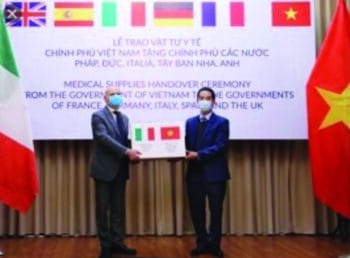
Vietnam’s Deputy Foreign Minister To Anh Dung hands a box of masks to Italy’s Ambassador to Vietnam Antonio Alessandro.
That all said, COVID isn’t merely business as usual. We see some telling reversals. Britain accepted shipments of masks from Vietnam.6 Cuba sent doctors to NATO member Italy.7 And Senegal turned around COVID tests in four hours, while in the U.S. such tests, even when available, were taking up to ten days.8
These telltales are underway during what the world-systems theorists describe as a major shift in the prevalent cycles of capital accumulation that have structured much of the world order the past 500 years.9 The pandemic serves as much as a marker of such a shift as a shockingly immediate crisis. The United States, on the tail end of its cycle of accumulation, turning capital back to money for the wealthiest – that is, cashing out – is, outside its military budget, no longer newly investing in the infrastructure of global empire.
U.S. power, for instance, was until this outbreak on the hook for cleaning up pandemics that capital the world over helped create.10 The U.S. tasked itself with keeping the global system on the same developmental path despite the ultimately unsustainable (and hideous) destruction to land and people that path represents. So defunding the World Health Organization, as the U.S. did, wasn’t an exercise in imperial might.11 It was a white flag, a capitulation.
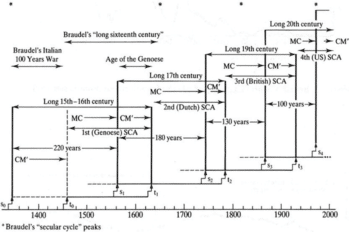
World-systems theorist Giovanni Arrighi’s riff on Fernand Braudel. Capital accumulation – MC, money to capital – followed by busts of serial empire cashing out – CM’, capital to money: the Italian city states, Spain not shown here, the Dutch, the British empire, and the U.S. century.
Domestically, the U.S. failures to respond to its own outbreak were more than missteps by the Trump administration, and were programmed in decades ago as the shared commons of public health were simultaneously neglected and sold off.12 A country captured by a regimen of individualized, just-in-time epidemiology – an utter contradiction – with barely enough hospital beds and equipment for normal operations, was unable to marshal the resources necessary to pursue the scale of disease suppression that a COVID outbreak demands.
Indeed, many a New Yorker denied access to a critical care bed and then gasping for breath on their couches at home had much more in common with a West African infected with Ebola in a structurally adjusted health care system than with any other New Yorker wealthy enough to pay for medical care on demand.13 Nearly two thousand New Yorkers were found dead in their homes the first eight days of April 2020.14
Rural areas also got pummeled.15 Louisa County in Iowa, home to a Tyson company meat packing plant through which COVID burned right through, at one point hosted more cases per capita than New York State.16 The county, home to 11,000 people, had neither a hospital nor a practicing physician living there.
China, in contrast, is on the front end of its cycle of accumulation.17 It is invested in building the infrastructure, including global public health, it needs to turn money into capital (and imperial might). Such a transition – U.S. to China – is neither assured nor absolves China of its public health ills, including producing conditions for COVID-19’s very emergence as we’ll discuss further.18 But we should note that the structural impulse there is different. Indeed, upon an initial stumble, China moved to eradicate COVID from Hubei, the province of origin, by deploying 40,000 medical staff from other provinces and conducting comprehensive contact tracing and testing.19 China donated millions in U.S. dollars to its African trade partners to fight COVID.20
Beyond this contrast of two giants, the question of why some countries escaped the worst of the outbreak is worth comment. There was a matter of geography. How close to an epicenter? South America and Africa started up late this way. But even countries bordering China escaped the worst of it. It helps if a government both prepares the country during the advance warning it’s been given and sees the shared commons as still part of the purview of governance.
Retweet of Vietnam Ministry of Health contact tracing for international flights with documented COVID-19 case onboard. Hotline number provided. Contrast the response with the Trump announcement that scared home phalanxes of Americans in Europe, crowded through airports without testing or follow-up.
Taiwan, for instance, tested people at the airport for COVID-19, disinfected their suitcases, drove each person separately to their destination in a government-provided taxi, and gave each arrival one phone app that tells them where in their area they’re staying that they could purchase a mask and another app that listed local infections and their case histories.21
Iceland aggressively tested its population and isolated the positive cases.22 It deployed detectives to contact-trace any infection. Those in contact with a case were also sequestered, so that if any of these people proved to be infected, they were already in quarantine. The rest of the country went about its business, walking free outside without masks.
Vietnam provided comprehensive health care to nearly the entirety of its population, and, unlike, say, Louisa County in Iowa, had doctors and nurses in every community.23 Along with the typical border protocols, like China, whole buildings were quarantined should a case be detected but the building’s occupants were provided three meals a day for a small charge. Apartment buildings hosted whole-body sanitizing stations at all entrances.24 Empty hotels were used as quarantine sites, where doctors made house calls. Everybody wore a mask. And unlike the U.S., where the federal government set off a black market bidding war for ventilators among its states, there were few if any reports from Vietnam of price gouging, panic buying, or hoarding.25
That said, all countries were in for a rough ride with the global economy already falling toward a recession before the outbreak began.26 Those countries pummeled worst by the pandemic found themselves farther in the fiscal hole. In an effort to fix outbreak and economy at the same time, the grim calculus of capital attempted to push the two crises of its own making onto the indigenous and the poorest workers worldwide. Brazil under Bolsonaro even before the Amazonian fires showed that calculus.27 But also, in the U.S., the government aimed to reduce the already criminal wages that immigrant farmworkers were making as “pandemic relief” for agricultural companies.28
Industrial agriculture and pandemics
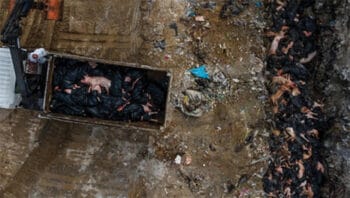
Hogs culled for African Swine Fever dumped in Hong Kong, May 2019.
Our cycles of accumulation – the U.S. cashing out and China ramping up – impacted COVID’s very origins. Over the past forty years, China chose to engage in massive shifts in land use and migration to domestically feed and pay its population.29 These shifts had considerable impact in decoupling (and recoupling) traditional ecologies into new configurations that had a profound effect on economy and epidemiology alike. So we see post-economic liberalization, the rise of multiple strains of new influenzas, including H5N1, H6N1, H7N9, and H9N2, as well as SARS-1 and, now, an explosion in cases of African Swine fever which killed half of China’s hogs in 2019.30
There is some controversy as to COVID’s local origins, but the genetics of the virus – SARS-CoV-2 – show it to be recombinant of a bat coronavirus and a pangolin strain that subsequently went through some attuning to the human immune system whether before or upon the Wuhan outbreak.31 But clearly agriculture had a role to play in this process even if that central Wuhan market didn’t. Somehow the virus got from one of the many coronaviruses documented to circulate among a variety of bat species in Central China into Wuhan proper.32 To claim agriculture had no impact, as China is moving toward as an official position, or absurdly, that the virus didn’t originate in China at all, would position opponents of agriculture’s role in a pretty precarious position.33 How to explain the move from bats through pangolins through perhaps another intermediate species such as hogs into humans without bringing up agriculture (or logging or mining)? The genetics don’t support a lab accident.34
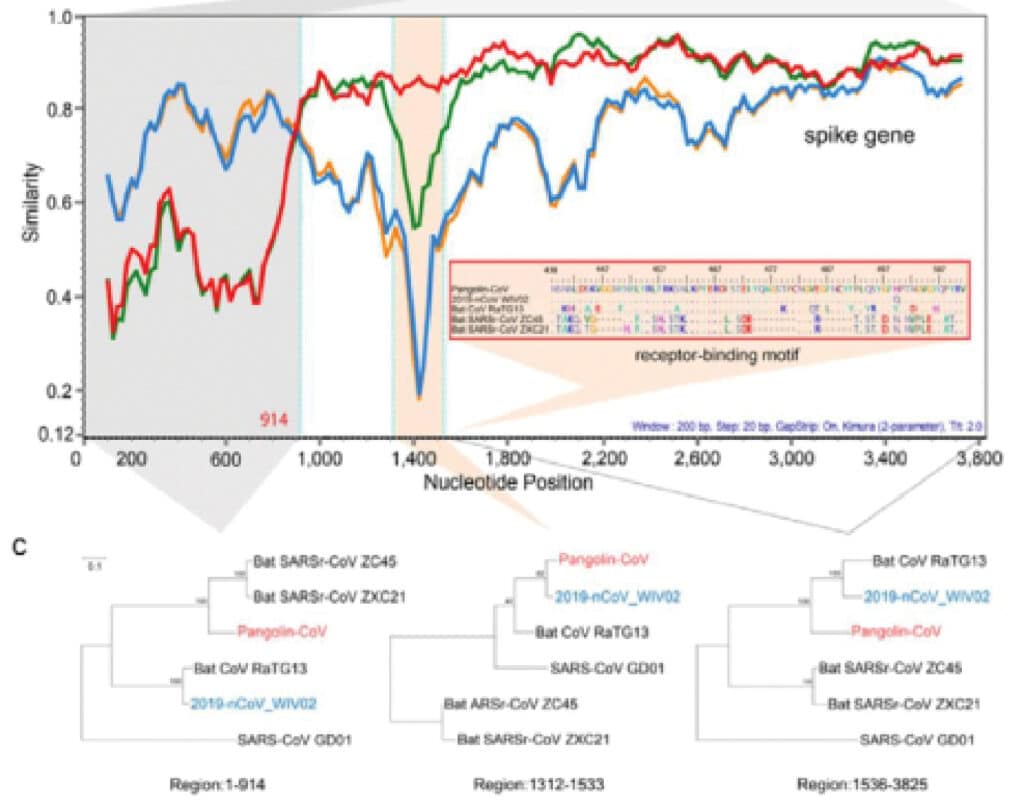 Similarity plot of the genetics of a pangolin strain of SARS with SARS-CoV-2 (“2019-nCoV”) and a series of bat coronaviruses. Most of the SARS-2 genome is similar to bat SARS sample CoV RaTG13, although another bat strain from Yunnan has since been shown to be related more closely. But it’s in the spike gene of the receptor-binding domain that SARS-2 uses to get into the human cell where SARS-2 is more similar to the pangolin strain. That indicates some recombination event occurred, when the pangolin strain spike gene transferred into the bat background before the strain adapted to the human receptor and went human-to-human. From Xiao et al. reference in endnote 31.
Similarity plot of the genetics of a pangolin strain of SARS with SARS-CoV-2 (“2019-nCoV”) and a series of bat coronaviruses. Most of the SARS-2 genome is similar to bat SARS sample CoV RaTG13, although another bat strain from Yunnan has since been shown to be related more closely. But it’s in the spike gene of the receptor-binding domain that SARS-2 uses to get into the human cell where SARS-2 is more similar to the pangolin strain. That indicates some recombination event occurred, when the pangolin strain spike gene transferred into the bat background before the strain adapted to the human receptor and went human-to-human. From Xiao et al. reference in endnote 31.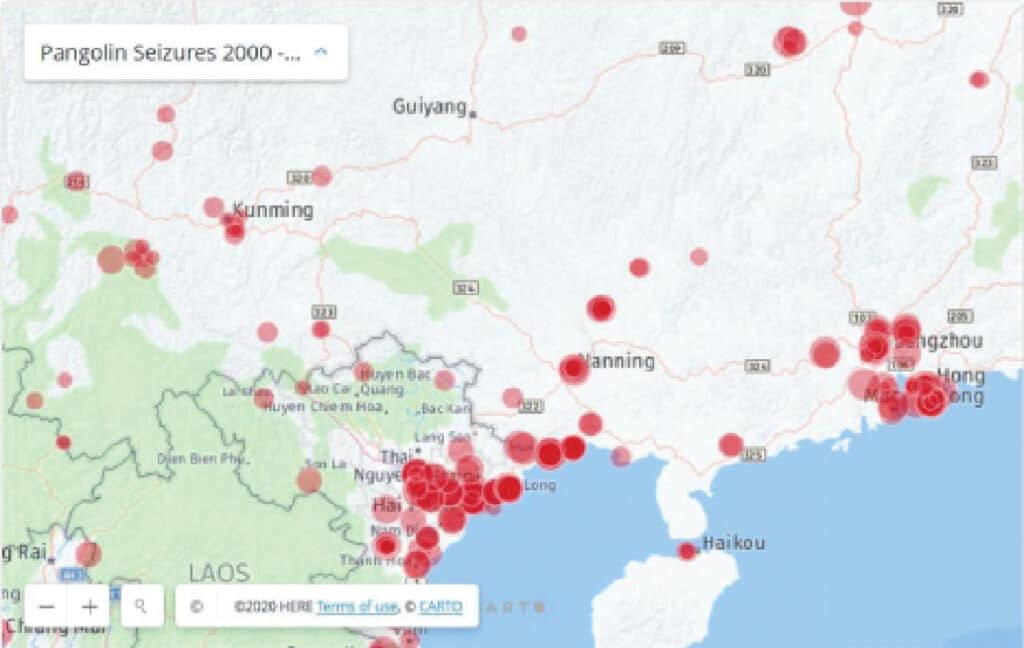 Seizures of illegal shipments of pangolin scales, 2000-2019, from some of the supply staging areas in Indochina and market targets in southern China (although that doesn’t preclude use outside of China as well). There is in addition an increasing push to farm the notoriously difficult to cultivate but lucrative pangolin. Source: Global Environmental Crime Tracker, Environmental Investigation Agency, https://eia-international.org/wildlife/wildlife-trade-maps/illegal-trade-seizures-pangolins/.
Seizures of illegal shipments of pangolin scales, 2000-2019, from some of the supply staging areas in Indochina and market targets in southern China (although that doesn’t preclude use outside of China as well). There is in addition an increasing push to farm the notoriously difficult to cultivate but lucrative pangolin. Source: Global Environmental Crime Tracker, Environmental Investigation Agency, https://eia-international.org/wildlife/wildlife-trade-maps/illegal-trade-seizures-pangolins/.In all likelihood an expanding regional circuit of production maneuvered both the increasingly formalized wild foods sector and industrial livestock production further into the hinterlands where both sectors increasingly encountered bat reservoirs.35 Periurban loops of growing extent and population density can increase the interface (and spillover) between wild nonhuman populations and newly urbanized rural areas. Those new geographies also reduce the kind of environmental complexity with which forests can disrupt the transmission of deadly viruses as we would like our forests to do.36
That regional circuit of production of COVID’s likely origins – forest through periurban to city – is reproduced around the world.37 This scenario offers a broader framework by which to organize our thinking about outbreaks nearly everywhere – not just China. SARS 1 and 2, Ebola, Zika, yellow fever, African swine fever, avian and swine influenzas, Nipah virus, Q fever, among others, and, historically, HIV, all originated or re-emerged somewhere along such expanding circuits of production, whether in the forest, in the new periurban continuum, or in factory farms or processing plants near or in cities. Many such new ecologies are driven by imperial or neoliberal imposition.38 Clearly infectious diseases aren’t merely matters of the virus itself, but also the context in which they emerge.39
Indeed, looking toward the future, we find coronavirses are only one of many pathogens developing in such an agroeconomic context. What we are suffering today is already also in motion somewhere else, many times over, like viral hurricanes lining up in the Atlantic Ocean.
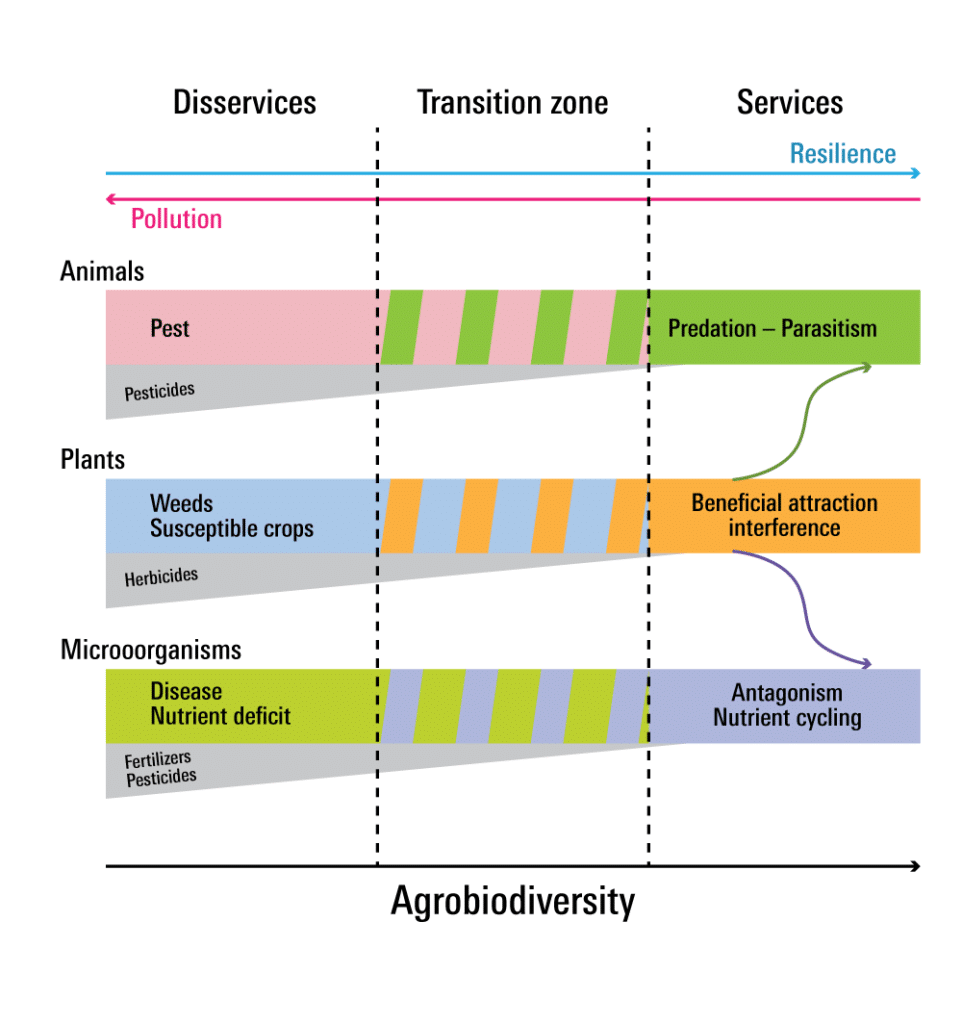
Agrobiodiversity promotes ecological services. The diversities promote healthier soils, beneficial insects, and pest predators, decreasing the need for agricultural inputs such as pesticides and fertilizers that pollute local environments and capture the near-entirety of farmer income. Diversities reintroduce genetic mosaics that help block the spread of pathogens at both the farm and region levels. From Corrado et al. in endnote 47.
Agroecology, habitat restoration, pandemic prevention
What to do? As perhaps a prompt for our conversation today, I’ll touch upon some possibilities if only as a series of questions.
Are we prepared to rebuild the town economies that permit farmers and fisher folk around the world the autonomy they need to source local inputs without destroying wilderness?40 Can we learn to learn from indigenous groups how to treat a landscape as much as a matter of our ethos as a source of food?41
Will we finally abandon settler ideologies? Will we reintroduce ourselves back into Earth’s cycles of regeneration?42 Can we rediscover our sense of individuation – who we are – in multitudes of people beyond what capital and the state offer us?43
Are we prepared to fight to reclaim rural and forest landscapes and local waters that agribusiness has turned into sacrifice zones for global capital?44 Will we aim to defeat agribusiness as both a mode of production and a political opponent – from its lobbying in State capitols to its campaigns in killing environmental activists along neoliberal frontiers of the forest edge?45
I believe these questions are the fires we must walk through in order to be able to introduce the now suddenly-obvious strategies in pandemic prevention:
Among them, we need to protect the forest complexity that keeps deadly pathogens from lining up livestock and human hosts for a straight shot onto the world’s travel network.46 We need to reintroduce the livestock and crop diversities, and reintegrate animal and crop farming at scales that keep pathogens from ramping up in deadliness.47 We must once again allow our food animals to reproduce onsite, restarting the natural selection that allows immune evolution to track pathogens in real time.
In short, what to do includes many of the very practices the indigenous and smallholders of the world engage in as a matter of course in their everyday cultivation.48 Can we scale these out specific to the needs of people and place? Can we, as the Zapatistas have been paraphrased, can we make un mundo donde quepan muchos mundos?49 – a world where many worlds fit?
—27 May 2020
Robert G. Wallace is an evolutionary epidemiologist at the Agroecology and Rural Economics Research Corps. He is author of Dead Epidemiologists: On the Origins of COVID-19, and Big Farms Make Big Flu; and co-author of Neoliberal Ebola: Modeling Disease Emergence from Finance to Forest and Farm, and Clear-Cutting Disease Control: Capital-Led Deforestation, Public Health Austerity, and Vector-Borne Infection. He has consulted for the Food and Agriculture Organization and the Centers for Disease Control.
References
- ↩Coronavirus Resource Center (2020) World Map, 25 May. COVID-19 Dashboard by the Center for Systems Science and Engineering (CSSE) at Johns Hopkins University. https://coronavirus.jhu.edu/map.html.
- ↩Li D, J Lv, G Botwin, J Braun, W Cao, L Li, and DPB McGovern (2020) Estimating the scale of COVID-19 epidemic in the United States: Simulations based on air traffic directly from Wuhan, China. MedRxiv, 8 March. https://www.medrxiv.org/content/10.1101/2020.03.06.20031880v1.article-info; Zhongwei Jia and Zuhong Lu (2020) Modelling COVID-19 transmission: from data to intervention. Lancet Infect Dis. doi: 10.1016/S1473- 3099(20)30258-9
- ↩Wu J, A McCann, J Katz, and E Peltier (2020) 74,000 missing deaths: Tracking the true toll of the coronavirus outbreak. New York Times, 19 May. https://www.nytimes.com/interactive/2020/04/21/world/coronavirus-missing-deaths.html.
- ↩Ndii D (2020) Thoughts on a pandemic, geoeconomics and Africa’s urban sociology. The Elephant, 25 March. https://www.theelephant.info/op-eds/2020/03/25/thoughts-on-a-pandemic-geoeconomics-and-africas-urban-sociology/; Kapara N, C Ihekweazu, F Ntoumi, et al. (2020) Is Africa prepared for tackling the COVID-19 (SARS- CoV-2) epidemic. Lessons from past outbreaks, ongoing pan-African public health efforts, and implications for the future. International Journal of Infectious Diseases, 93:233-236; Gilbert M, G Pullano, F Pinotti, E Valdano, et al. Preparedness and vulnerability of African countries against importations of COVID-19: a modelling study. The Lancet, 395(102777):871-877.
- ↩Zurayk R (2020) Pandemic and food security: A view from the Global South. Journal of Agriculture, Food Systems, and Community Development, 9(3). https://foodsystemsjournal.org/index.php/fsj/article/view/803/789.
- ↩Cockburn H (2020) Vietnamese children donate 20,000 face masks to UK after saving up ‘lucky money’. The Independent, 24 April. https://www.independent.co.uk/news/uk/home-news/vietnamese-children-donate-face-masks-uk-coronavirus-ppe-shortage-a9483276.html.
- ↩Augustin E (2020) Cuba has sent 2,000 doctors and nurses overseas to fight Covid-19. The Nation, 22 May. https://www.thenation.com/article/world/cuba-doctors-covid-19/.
- ↩Lange J (2020) Senegal is reportedly turning coronavirus tests around ‘within 4 hours’ while Americans might wait a week. Yahoo News, 12 March. https://news.yahoo.com/senegal-reportedly-turning-coronavirus-tests-165224221.html; Shryock R (2020) Senegal pledges a bed for every coronavirus patient – and their contacts, too. NPR, 17 May. https://www.npr.org/sections/goatsandsoda/2020/05/17/856016429/senegal-pledges-a-bed-for-every-coronavirus-patient-and-their-contacts-too.
- ↩Arrighi G (1994 [2010]). The Long Twentieth Century: Money, Power and the Origins of Our Times. Verso, London.
- ↩Tharoor I (2020) Trump’s pandemic response underscores the crisis in global politics. Washington Post, 16 April. https://www.washingtonpost.com/world/2020/04/17/trumps-pandemic-response-underscores-crisis-global-politics/
- ↩Allen L (2020) Defunding the WHO was a calculated decision, not an impromptu tweet. The Conversation, 20 April. https://theconversation.com/defunding-the-who-was-a-calculated-decision-not-an-impromptu-tweet-136620.
- ↩Waitzkin H (ed) (2018) Health Care Under the Knife: Moving Beyond Capitalism for Our Health. Monthly Review Press, New York.
- ↩Wallace RG and R Wallace (eds) (2016) Neoliberal Ebola: Modeling Disease Emergence from Finance to Forest and Farm. Springer, Cham.
- ↩Watkins A and WK Rashbaum (2020) How many people have actually died from coronavirus in New York? New York Times, 10 April. https://www.nytimes.com/2020/04/10/nyregion/new-york-coronavirus-death-count.html.
- ↩Thebault R and A Hauslohner (2020) Covid-19’s deadly new surge is in rural America as states re-open. Washington Post, 24 May. https://www.washingtonpost.com/nation/2020/05/24/coronavirus-rural-america-outbreaks/?arc404=true.
- ↩Rynard P (2020) Louisa County COVID-19 rate now worse than New York State. Iowa Starting Line, 13 April. https://iowastartingline.com/2020/04/13/louisa-county-covid-19-rate-now-worse-than-new-york-state/.
- ↩Arrighi G (2007) Adam Smith in Beijing: Lineages Of The 21st Century. Verso, New York.
- ↩Gulick J (2011) The Long Twentieth Century and barriers to China’s hegemonic accession. Journal of World-Systems Research, 17(1):4-38.
- ↩Brueck H, AM Miller, and S Feder (2020) China took at least 12 strict measures to control the coronavirus. They could work for the US, but would likely be impossible to implement. Business Insider, 24 March. https://www.businessinsider.com/chinas-coronavirus-quarantines-other-countries-arent-ready-2020-3.
- ↩Marques CF (2020) China in Africa is more than a land grab: Beijing is after political influence, and its coronavirus aid will count for much. Bloomberg, 27 April. https://www.bloomberg.com/opinion/articles/2020-04-27/china-s-coronavirus-aid-to-africa-will-build-political-support.
- ↩Wang CJ, CY Ng, and RH Brook (2020) Response to COVID-19 in Taiwan: Big data analytics, new technology, and proactive testing. JAMA, 323(14):1321-1342.
- ↩Marx W and MW Bishop (2020) Iceland employs detective work, testing and quarantine in coronavirus fight. NBC News, 27 March. https://www.nbcnews.com/news/world/iceland-employs-detective-work-testing-quarantine-coronavirus-fight-n1170166.
- ↩Le SM (2020) Containing the coronavirus (COVID-19): Lessons from Vietnam. World Bank Blogs, 30 April. https://blogs.worldbank.org/health/containing-coronavirus-covid-19-lessons-vietnam.
- ↩Thanh N (2020) Covid-19 innovation: Vietnam’s mobile chambers allow disinfection in one go. VN Express, 16 March. https://e.vnexpress.net/news/news/covid-19-innovation-vietnam-s-mobile-chambers-allow-disinfection-in-one-go-4069276.html.
- ↩Ashwill MA (2020) Vietnam: An outlier in the coronavirus epidemic and HE? University World News, 14 March. https://www.universityworldnews.com/post.php?story=20200313063615630.
- ↩Roberts M (2020) It was the virus that did it. Michael Roberts Blog, 15 March. https://thenextrecession.wordpress.com/2020/03/15/it-was-the-virus-that-did-it/.
- ↩Diele-Viegas LM and CFD Rocha (2020) Why releasing mining on Amazonian indigenous lands and the advance of agrobusiness is extremely harmful for the mitigation of world’s climate change? Comment on Pereira et al. (Environmental Science & Policy 100 (2019) 8–12). Environmental Science & Policy, 103:30-31; Londoño E and L Casado (2020) As Bolsonaro keeps Amazon vows, Brazil’s Indigenous fear ‘ethnocide’. New York Times, 19 April. https://www.nytimes.com/2020/04/19/world/americas/bolsonaro-brazil-amazon-indigenous.html.
- ↩Ordoñez F (2020) White House seeks to lower farmworker pay to help agriculture industry. NPR News, 10 April. https://www.npr.org/2020/04/10/832076074/white-house-seeks-to-lower-farmworker-pay-to-help-agriculture-industry.
- ↩Wallace RG, L Bergmann, L Hogerwerf, and M Gilbert (2010) Are influenzas in southern China byproducts of the region’s globalising historical present? In S Craddock, T Giles-Vernick, and J Gunn (eds) Influenza and Public Health: Learning from Past Pandemics. EarthScan Press, London.
- ↩Liu Q, L Cao, and X-Q Zhu (2014) Major emerging and re-emerging zoonoses in China: a matter of global health and socioeconomic development for 1.3 billion. International Journal of Infectious Diseases, 25:65-72; Vergne T, C Chen-Fu, S Li, J Cappelle, J Edwards, et al. (2017) Pig empire under infectious threat: risk of African swine fever introduction into the People’s Republic of China. Vet Record, 181(5):117.
- ↩Andersen KG, A Rambaut, WI Lipkin, and EC Holmes. The proximal origin of SARS-CoV-2. Nature Medicine, 26:450-452; Xiao K, J Zhai, Y Feng, N Zhou, X Zhang, et al. (2020) Isolation and characterization of 2019-nCoV- like coronavirus from Malayan pangolins. bioRxiv. https://www.biorxiv.org/content/10.1101/2020.02.17.951335v1.
- ↩Wu Z, L Yang, X Ren, G He, J Zhang, et al. (2016) Deciphering the bat virome catalog to better understand the ecological diversity of bat viruses and the bat origin of emerging infectious diseases. ISME J, 10(3):609-620.
- ↩Choy G, T Ng, B Jaipragas, J Ma, and Z Pinghi (2020) South Korea tops China for first time. South China Morning Post, 27 Feburary. https://www.scmp.com/news/china/society/article/3052577/coronavirus-south-korea-infections-could-exceed-china-which.
- ↩Andersen KG, A Rambaut, WI Lipkin, and EC Holmes. The proximal origin of SARS-CoV-2.
- ↩Field HE (2009) Bats and emerging zoonoses: Henipaviruses and SARS. Zoonoses and Public Health, 56(6-7):278- 284; Afelt A, R Frutos, and C Devaux (2018) Bats, Coronaviruses, and deforestation: Toward the emergence of novel infectious diseases? Frontiers in Microbiology, 9:702; Wallace RG, A Liebman, LF Chaves, and R Wallace (2020) COVID-19 and circuits of capital. Monthly Review, 72(1). https://monthlyreview.org/2020/05/01/covid-19-and-circuits-of-capital/; Wallace RG (2020) Midvinter-19. Patreon, 5 May. https://www.patreon.com/posts/midvinter-19-36797182; Fisher G (2020) Deforestation and monoculture farming spread COVID-19 and other diseases. TruthOut, 12 May. https://truthout.org/articles/deforestation-and-monoculture-farming-spread-covid-19-and-other-diseases/.
- ↩Wallace R, LF Chaves, LR Bergmann, C Ayres, L Hogerwerf, R Kock, and RG Wallace (2018) Clear-Cutting Disease Control: Capital-Led Deforestation, Public Health Austerity, and Vector-Borne Infection. Springer, Switzerland.
- ↩Wallace RG, A Liebman, LF Chaves, and R Wallace (2020) COVID-19 and circuits of capital; Wallace RG (2021) Agriculture, capital, and infectious diseases. In Hans Harren, et al., IAASTD – Ten Years After. In press.
- ↩Wallace RG and R Wallace (eds) (2016) Neoliberal Ebola: Modeling Disease Emergence from Finance to Forest and Farm.
- ↩Wallace RG (2016) Big Farms Make Big Flu. Monthly Review Press, New York.
- ↩IPES-Food (2016) From Uniformity to Diversity: A Paradigm Shift from Industrial Agriculture to Diversified Agroecological Systems. Louvain-la-Neuve, Belgium. http://www.ipes-food.org/_img/upload/files/UniformityToDiversity_FULL.pdf; IPES-Food (2018) Breaking Away from Industrial Food and Farming Systems: Seven Case Studies of Agroecological Transition. Louvain-la-Neuve, Belgium. http://www.ipes-food.org/_img/upload/files/CS2_web.pdf; Chappell, M.J (2018) Beginning to End Hunger: Food and the Environment in Belo Horizonte, Brazil, and Beyond. University of California Press, Berkeley; Arias PF, T Jonas, and K Munksgaard (eds) (2019) Farming Democracy: Radically Transforming the Food System from the Ground Up; Australian Food Sovereignty Alliance. Vivero-Pol JL, T Ferrando, O De Schutter, and U Mattei (eds) (2019) Routledge Handbook of Food as a Commons. Routledge, New York; Giraldo OF (2019) Political Ecology of Agriculture: Agroecology and Post-Development. Springer, Cham.
- ↩Suárez-Torres J, J Ricardo Suárez-López, D López-Paredes, H Morocho, LE Cachiguango-Cachiguango, and W Dellai (2017) Agroecology and health: Lessons from Indigenous populations. Current Environmental Health Reports, 4:244–25; Pascoe B (2018) Dark Emu: Aboriginal Australia and the Birth of Agriculture. Scribe, London; Figueroa-Helland L, C Thomas, and AP Aguilera (2018) Decolonizing food systems: Food sovereignty, indigenous revitalization, and agroecology as counter-hegemonic movements. Perspectives on Global Development and Technology, 17(1-2):173-201.
- ↩Mandel E (1970) Progressive disalienation through the building of socialist society, or the inevitable alienation in industrial dociety? In The Marxist Theory of Alienation. Pathfinder, New York; Foster JB (2018) Marx, value, and nature. Monthly Review, 70(3):122-136; Wallace RG, K Okamoto, and A Liebman (2021) Earth, the alien planet. In DB Monk and M Sorkin (eds) Between Catastrophe and Redemption: Essays in Honor of Mike Davis. OR Books, New York. In press.
- ↩Virno P (2004) A Grammar of the Multitude. Semiotext(e), Los Angeles; Federici S (2018) Re-enchanting the World: Feminism and the Politics of the Commons. PM, Oakland.
- ↩Oliveira G and S Hecht (2016) Sacred groves, sacrifice zones and soy production: globalization, intensification and neo-nature in South America. Journal of Peasant Studies, 43:251-285; Edelman M (2019) Hollowed out Heartland, USA: How capital sacrificed communities and paved the way for authoritarian populism. Journal of Rural Studies. https://www.sciencedirect.com/science/article/abs/pii/S0743016719305157.
- ↩Wallace R, L Hogerwerf, A Liebman, L Bergmann, and RG Wallace. Agribusiness vs. public health: Disease control in resource-asymmetric conflict. Preprint available at https://hal.archives-ouvertes.fr/hal-02513883.
- ↩Wallace R, LF Chaves, LR Bergmann, C Ayres, L Hogerwerf, R Kock, and RG Wallace (2018) Clear-Cutting Disease Control: Capital-Led Deforestation, Public Health Austerity, and Vector-Borne Infection.
- ↩Corrado C, T Elena, R Giancarlo, and C Stefano (2019) The role of agrobiodiversity in sustainable food systems design and management. In D Nandwani (ed), Genetic Diversity in Horticultural Plants. Springer, Cham, pp 245-271; Wallace RG, A Liebman, D Weisberger, T Jonas, L Bergmann, R Kock, and R Wallace (In press) Industrial agricultural environments. In J Fall, R Francis, MA Schlaepfer, and K Barker (eds) The Routledge Handbook of Biosecurity and Invasive Species. Routledge, New York.
- ↩Kremen C, A Iles, and C Bacon (2012) Diversified farming systems: An agroecological, systems-based alternative to modern industrial agriculture. Ecology and Society, 17(4):44; Magne M-A, G Martin, M Moraine, J Ryschawy, V Thenard et al. (2019) An integrated approach to livestock farming systems’ autonomy to design and manage agroecological transition at the farm and territorial levels. In J-E Bergez, E Audouin, and O Therond (eds) Agroecological Transitions: From Theory to Practice in Local Participatory Design. Springer, Cham, pp 45-68.
- ↩EZLN-CCRI (2005) Sixth Declaration of the Lacandon Jungle (Sexta Declaración de la Selva Lacandona). http://www.elkilombo.org/wp-content/uploads/SextaDecDeLaSelva-Espanol-Booklet.pdf; Ortega FIM and FA Zañartu Toloza (2017) Un mundo donde quepan muchos mundos: Neozapatismo y el EZLN en México. Revista Espacios & Memorias, Nº 2. Universidad Metropolitana de Ciencias de la Educación, Chile.
No comments:
Post a Comment